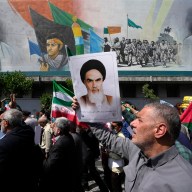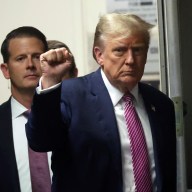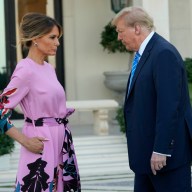He’s just returned from a trip to The White House where First Lady Michelle Obama honoured him with a Cooper-Hewitt National Design Award for his fashion design work for Calvin Klein Collection. It’s the third major award the Brazilian native has won in the past four years. (He won the prestigious Women’s Wear Designer of the Year award from the Council of Fashion Designers of America in 2006 and 2008.) In the process he’s become a ray of hope of sorts for the New York fashion industry.
Not only has he managed to take the helm of an iconic fashion house from its living founder and evolve the brand in a meaningful way, he’s also become a star in his own right. Years ago, Calvin Klein was most known for its denim and provocative ad campaigns. Today, its womenswear, designed by Costa, 43, is widely viewed as one of the best in the industry.
Other designers who have stepped into the shoes of living legends have not fared nearly as well. (Alber Elbaz, for example, struggled designing for Yves Saint Laurent in the shadow of the French house’s then still living namesake.) It will be interesting to see what happens at the houses of the other two members of New York’s old guard fashion trifecta, Ralph Lauren and Donna Karan, further down the line.
In the meantime, Costa, who designed for Oscar de la Renta and Gucci before heading up Calvin Klein Collection, has more work to do. We met him at the brand’s New York headquarters as he prepared to begin creating his spring 2010 collection.
Congratulations on the award! How did it feel to win?
It was incredible because it’s not just fashion. It’s design across the board and on a national level at that. I went to the Cooper-Hewitt museum all the time. It’s such an incredible fountain. The museum has always been a bit up there. So to now be a part of it is very thrilling. It was just really meaningful. And the association of Mrs. Obama and the White House just made things even more wild.
What do you think of the influence Michelle Obama has had on American fashion?
I think she stands out for being so brave and thinking out of the box. The thinking is what’s probably of great distinct. She’s bringing more people in and being more inclusive than exclusive. That’s something that we believe in here in this house. The more people we dress, the more categories we have, the stronger the company is. It’s a very modern way of thinking.
What were your earliest impressions of Calvin Klein?
Well before I moved to the U.S., I remember (the ads with) Brooke Shields. She just made a huge splash. So that was like really defined. And then I really felt how strong the label was. It was huge. So provocative. It was incredible.
Your mother ran a clothing factory in Brazil. What kind of work did she do there and how did it influence you?
Well, she started her company by selling fabrics but she used to make garments as well. My mom once did this dress for my cousin´s wedding, and I was just like, “Wow, what is this thing?” That dress was so crazy. It was very simple and architectural but then it had this headpiece that I don’t know how she came up with.
Later, I looked back and realized that the dress was basically based on a Balenciaga. And it was an amazing reference because we lived in the middle of this tiny little town called Guarani. She was very forward for her time. I mean she had her magazines, which we weren’t allowed to touch. But she was obviously inspired by the photos in them. It was not your traditional bridal gown.
And I remember not knowing whether I liked it or not. But I never thought it had any influence on me at the time. She was just my mother.
What were your experiences like in the factory?
It was a very small town, about 3,000 people, you know? And she had the largest business in town. She employed all women and she created a home for the children of the mothers who worked for her. It was our town’s earliest example of day care, a concept that was kind of foreign at the time. She just had great ideas and knew how to put them into practice. But I’m going off-track. We used to leave school and go home and there would be no rest. We had to go to the factory and work.
Did that work ethic carry over to your adult life?
I think I got a little bit of that side of her. The restlessness. Do you know the tag guns that dispense the plastic tags? Well before that was created we had to make them ourselves. So I would line up the tags on a table and I had to pull the thread through each one of those tags
and knot it. That was my first job. It was insane and would take days to complete. Those are good memories though.
So when you moved to the States and began studying fashion at F.I.T., was it difficult to adjust to New York’s fashion scene after living in such a small town?
I think so. But then again, I felt like it was heaven, being in New York by myself. It was in the height of the ’80s, about 1986. I was really inspired by everything that was happening. There was the whole series of Japanese fashion. Comme des Garçons, Yohji (Yamamoto) — it was all animated and fashiony and just great design. And then you had Calvin and Halston, which was so chic and glamorous.
And I remember trying to save so much money to buy a Jean Paul Gaultier jacket. Fashion was really full on at the time. I was also soaking in everything that was happening on the streets and in the clubs in the city. I was just living it and not really reflecting on what was happening at the time. But then, the more I began to really understand the culture in New York the more I began to understand the great fashion that inspired these people.
You’ve worked for completely different, yet equally unique fashion houses. What were those transitions like going from one house to the next?
I think that’s something that always haunted me, going from job to job. I always questioned the transition. Working with Oscar was one very strong aesthetic that I had to learn. And then from there to Gucci, which was like night and day. Before I went there, Tom Ford called me and told me to get a lawyer. And I was like, ‘Why?’ And he said, ‘I want you to come work for me.’ I never thought I’d be the right match.
And then Calvin approached me. But I always figured it out. I think there always has to be a certain amount of insecurity there, otherwise you’re too comfortable and complacent.
But was it difficult creating your vision for Calvin Klein considering that he’s still alive?
I’m lucky in that I was left with this legacy but I’m not constricted.
Do you feel like it’s easier to design for the brand now than it was in the beginning?
No. I never want to get too comfortable. I think it has to be that way, really.
Coming from Brazil, how did you develop your vision of how American women should dress?
To be honest, I’m still learning this. But the cool thing is that American women today are much different from how we imagined them in the past. Now we travel much more and have greater access to information. The world has become one. So I think when you think of how to dress American women, you have to dress women in general. We’ve made a lot of progress. The brand was associated with one type of woman and now we have broadened.
Your work is known for being quite intellectual. Do you have any low-brow, guilty pleasures?
Of course, I’m the devil (laughs.) But I don’t think my work is so intellectual at all. I think when I try to do a collection there’s an element of thought behind it. It’s not just the ABC of making clothes. Maybe the intellectual part comes into play when people react to it.
You’ve been in a long-term relationship for many years. How do you balance love and work at this level?
It all becomes one. He’s much more a part of what I do now than in the beginning. He comes with me to events much more now. So having him as a part of that makes it easier on the relationship. We’ve been together for 20 years. A lot of it as about making compromises. But I’d much rather to do that with someone I love and respect than not.
Could you one day see yourself balancing your work for Calvin Klein with designing your own clothing line?
That would be nice (smile.)
















